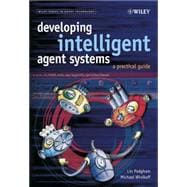
Lin Padgham is the author of Developing Intelligent Agent Systems: A Practical Guide, published by Wiley.
Michael Winikoff is the author of Developing Intelligent Agent Systems: A Practical Guide, published by Wiley.
| Foreword from the Series Editor | ix | ||||
| Preface | xi | ||||
| Acknowledgement | xiii | ||||
|
1 | (6) | |||
|
1 | (3) | |||
|
4 | (3) | |||
|
7 | (14) | |||
|
7 | (1) | |||
|
8 | (2) | |||
|
10 | (2) | |||
|
12 | (1) | |||
|
13 | (6) | |||
|
14 | (2) | |||
|
16 | (3) | |||
|
19 | (2) | |||
|
21 | (12) | |||
|
22 | (1) | |||
|
23 | (4) | |||
|
24 | (1) | |||
|
25 | (1) | |||
|
26 | (1) | |||
|
27 | (2) | |||
|
29 | (4) | |||
|
33 | (20) | |||
|
34 | (7) | |||
|
35 | (1) | |||
|
36 | (5) | |||
|
41 | (2) | |||
|
43 | (4) | |||
|
45 | (1) | |||
|
46 | (1) | |||
|
47 | (4) | |||
|
48 | (2) | |||
|
50 | (1) | |||
|
51 | (2) | |||
|
53 | (14) | |||
|
56 | (1) | |||
|
56 | (7) | |||
|
63 | (2) | |||
|
65 | (2) | |||
|
67 | (14) | |||
|
68 | (6) | |||
|
74 | (3) | |||
|
77 | (4) | |||
|
81 | (18) | |||
|
82 | (1) | |||
|
82 | (2) | |||
|
84 | (4) | |||
|
88 | (3) | |||
|
91 | (3) | |||
|
94 | (5) | |||
|
95 | (1) | |||
|
95 | (1) | |||
|
96 | (1) | |||
|
97 | (2) | |||
|
99 | (10) | |||
|
100 | (2) | |||
|
102 | (1) | |||
|
103 | (3) | |||
|
106 | (3) | |||
|
109 | (16) | |||
|
110 | (2) | |||
|
112 | (4) | |||
|
113 | (2) | |||
|
115 | (1) | |||
|
116 | (1) | |||
|
117 | (1) | |||
|
118 | (1) | |||
|
118 | (1) | |||
|
119 | (6) | |||
|
120 | (1) | |||
|
120 | (1) | |||
|
121 | (2) | |||
|
123 | (2) | |||
|
125 | (14) | |||
|
125 | (2) | |||
|
127 | (1) | |||
|
127 | (11) | |||
|
128 | (2) | |||
|
130 | (3) | |||
|
133 | (1) | |||
|
134 | (2) | |||
|
136 | (2) | |||
|
138 | (1) | |||
| A Electronic Bookstore | 139 | (60) | |||
| B Descriptor Forms | 199 | (6) | |||
| C The AUML Notation | 205 | (10) | |||
| Bibliography | 215 | (6) | |||
| Index | 221 |
The New copy of this book will include any supplemental materials advertised. Please check the title of the book to determine if it should include any access cards, study guides, lab manuals, CDs, etc.
The Used, Rental and eBook copies of this book are not guaranteed to include any supplemental materials. Typically, only the book itself is included. This is true even if the title states it includes any access cards, study guides, lab manuals, CDs, etc.